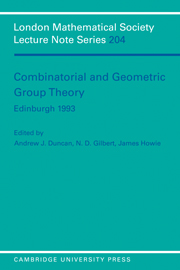Book contents
- Frontmatter
- Contents
- Foreword
- Participants
- On bounded languages and the geometry of nilpotent groups
- Finitely presented groups and the finite generation of exterior powers
- Semigroup presentations and minimal ideals
- Generalised trees and Λ-trees
- The mathematician who had little wisdom: a story and some mathematics
- Palindromic automorphisms of free groups
- A Freiheitssatz for certain one-relator amalgamated products
- Isoperimetric functions of groups and exotic cohomology
- Some embedding theorems and undecidability questions for groups
- Some results on bounded cohomology
- On perfect subgroups of one-relator groups
- Weight tests and hyperbolic groups
- A non-residually finite, relatively finitely presented group in the variety N2A
- Hierarchical decompositions, generalized Tate cohomology, and groups of type (FP)∞
- Tree-lattices and lattices in Lie groups
- Generalisations of Fibonacci numbers, groups and manifolds
- Knotted surfaces in the 4-sphere with no minimal Seifert manifolds
- The higher geometric invariants of modules over Noetherian group rings
- On calculation of width in free groups
- Hilbert modular groups and isoperimetric inequalities
- On systems of equations in free groups
- Cogrowth and essentiality in groups and algebras
- Regular geodesic languages for 2-step nilpotent groups
- Finding indivisible Nielsen paths for a train track map
- More on Burnside's problem
- Problem Session
Knotted surfaces in the 4-sphere with no minimal Seifert manifolds
Published online by Cambridge University Press: 05 April 2013
- Frontmatter
- Contents
- Foreword
- Participants
- On bounded languages and the geometry of nilpotent groups
- Finitely presented groups and the finite generation of exterior powers
- Semigroup presentations and minimal ideals
- Generalised trees and Λ-trees
- The mathematician who had little wisdom: a story and some mathematics
- Palindromic automorphisms of free groups
- A Freiheitssatz for certain one-relator amalgamated products
- Isoperimetric functions of groups and exotic cohomology
- Some embedding theorems and undecidability questions for groups
- Some results on bounded cohomology
- On perfect subgroups of one-relator groups
- Weight tests and hyperbolic groups
- A non-residually finite, relatively finitely presented group in the variety N2A
- Hierarchical decompositions, generalized Tate cohomology, and groups of type (FP)∞
- Tree-lattices and lattices in Lie groups
- Generalisations of Fibonacci numbers, groups and manifolds
- Knotted surfaces in the 4-sphere with no minimal Seifert manifolds
- The higher geometric invariants of modules over Noetherian group rings
- On calculation of width in free groups
- Hilbert modular groups and isoperimetric inequalities
- On systems of equations in free groups
- Cogrowth and essentiality in groups and algebras
- Regular geodesic languages for 2-step nilpotent groups
- Finding indivisible Nielsen paths for a train track map
- More on Burnside's problem
- Problem Session
Summary
Let Mn be an n-dimensional smooth manifold in the (n + 2)-sphere Sn + 2, and let Sn + 2 – N(Mn) be the complement of an open regular neighbourhood of Mn in Sn + 2. A Seifert manifold H of Mn is a compact orientable (n + 1)-dimensional submanifold of Sn + 2 such that the boundary of H is Mn. Moreover, if the induced homomorphism from π1(H) into π1(Sn + 2 – N(Mn)) is one-to-one, then the Seifert manifold H is called minimal.
One important case is when Mn is a sphere, i.e. a knot. The existence of Seifert manifolds of knots of any dimension is known. It is well known that the Seifert surfaces of 1-knots with minimal genus are minimal. Gutierrez [1] asserted the existence of minimal Seifert manifolds for knots of any dimension. However, his proof has a gap. For n ≥ 3, Silver [6] has given examples of n-dimensional knots with no minimal Seifert manifolds. Necessary and sufficient conditions for an n-knot (n ≥ 3) to have a minimal Seifert manifold have been given in [7].
In this paper we prove the following result:
Theorem. For any integer g ≥ 1, there exist closed orientable surfaces of genus g in S4 which have no minimal Seifert manifolds and no trivial 1-handles.
This result was presented to KOOK topology seminar in Osaka in September 1989, and at KNOT 90 in Osaka in 1990. The existence of 2-knots with no minimal Seifert manifolds is still an open question.
- Type
- Chapter
- Information
- Combinatorial and Geometric Group Theory, Edinburgh 1993 , pp. 239 - 246Publisher: Cambridge University PressPrint publication year: 1994



